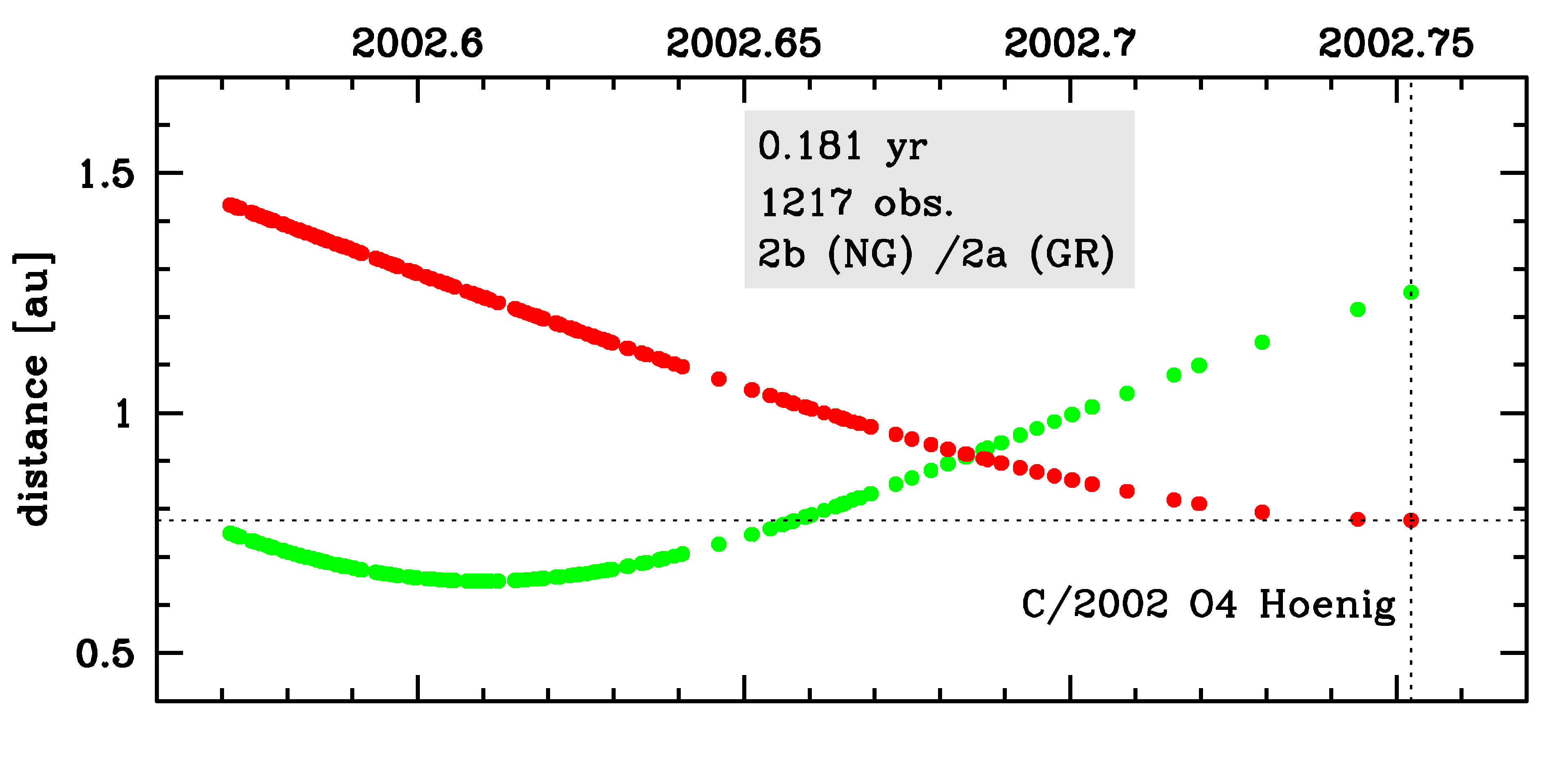C/2002 O4 Hoenig
more info
Comet C/2002 O4 was discovered on 22 July 2002 by Sebastian Hoenig (Dossenheim, Germany), that is about two months before its perihelion passage. It was observed until 1 October 2002.
Observers reported that C/2002 O4 started to disintegrate a few days before the perihelion, then faded very rapidly prior to perihelion passage; and in mid-October 2002, it was no longer possible to see this comet. Sekanina (2002) speculated that the comet was undergoing a major outburst near the time of its discovery (27 July 2002) and that a major loss of mass triggered by this episode completed in mid-August. The data arc for this comet is extremely short (two months); however, NG effects are easy detectable in its motion.
Preffered solution given here is based on pre-perihelion data spanning over 0.118 yr in a range of heliocentric distances from 1.43 au to 0.895 au (8 September 2002).
Comet had its closest approach to the Earth on 10 August 2002 (0.650 au), about 2 weeks after its discovery.
The NG orbit obtained from the full data arc gives negative original 1/a, whereas the NG orbit derived using a shorter data arc (see preferred orbit) results in a closed original orbit with semimajor axis shorter than 5000 au, indicating that the orbit of this comet is poorly known.
See also Sekanina 2019 and Królikowska 2020.
Observers reported that C/2002 O4 started to disintegrate a few days before the perihelion, then faded very rapidly prior to perihelion passage; and in mid-October 2002, it was no longer possible to see this comet. Sekanina (2002) speculated that the comet was undergoing a major outburst near the time of its discovery (27 July 2002) and that a major loss of mass triggered by this episode completed in mid-August. The data arc for this comet is extremely short (two months); however, NG effects are easy detectable in its motion.
Preffered solution given here is based on pre-perihelion data spanning over 0.118 yr in a range of heliocentric distances from 1.43 au to 0.895 au (8 September 2002).
Comet had its closest approach to the Earth on 10 August 2002 (0.650 au), about 2 weeks after its discovery.
The NG orbit obtained from the full data arc gives negative original 1/a, whereas the NG orbit derived using a shorter data arc (see preferred orbit) results in a closed original orbit with semimajor axis shorter than 5000 au, indicating that the orbit of this comet is poorly known.
See also Sekanina 2019 and Królikowska 2020.
| solution description | ||
|---|---|---|
| number of observations | 1217 | |
| data interval | 2002 07 27 – 2002 10 01 | |
| data type | observed only before perihelion (PRE) | |
| data arc selection | entire data set (STD) | |
| range of heliocentric distances | 1.43 au – 0.78 au (perihelion) – 0.77 au | |
| detectability of NG effects in the comet's motion | comet lost close to perihelion or split comet | |
| type of model of motion | GR - gravitational orbit | |
| data weighting | YES | |
| number of residuals | 2418 | |
| RMS [arcseconds] | 0.52 | |
| orbit quality class | 2a | |
| orbital elements (barycentric ecliptic J2000) | ||
|---|---|---|
| Epoch | 1713 07 08 | |
| perihelion date | 2002 10 01.52581153 | ± 0.00008454 |
| perihelion distance [au] | 0.77700885 | ± 0.00000458 |
| eccentricity | 1.00062355 | ± 0.00001291 |
| argument of perihelion [°] | 105.940448 | ± 0.000543 |
| ascending node [°] | 320.975467 | ± 0.000139 |
| inclination [°] | 73.123131 | ± 0.000209 |
| reciprocal semi-major axis [10-6 au-1] | -802.50 | ± 16.61 |
| file containing 5001 VCs swarm |
|---|
| 2002o4a1.bmi |

